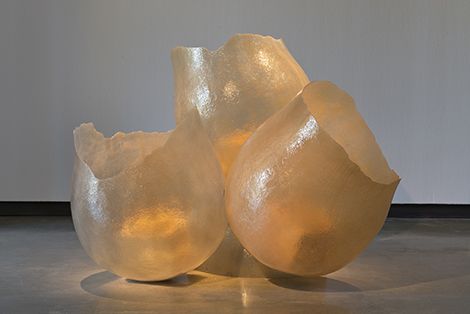“A Better Nectar” is a rare exhibition merging art with nature, while focusing on the daily activities of bees—those diligent flying insects that pollinate our planet. Among this show’s surprising pieces are several larger-than-life fiberglass sculptures that replicate the various objects of the bees’ attentions. These pieces, along with a light sculpture and the interpretive, “musical” sounds of foraging bees and of pollen being released, follow a multisensory journey, starting from the bees’ nests and concluding at their nurturing nectar collection.
The centerpiece of this exhibition is Resonant Nest (all works 2014)—19 honey-colored 36-inch-high fiberglass sculptures of hatched bee eggs. These sensuous, bell-shaped objects, gathered into three clusters and theatrically lit to emphasize their incandescent qualities are complemented by haunting music emanating from speakers installed within their organic shapes. The music, composed by Robert Hoehn, who is himself a bee keeper, calls up the diurnal activities of bumblebees as they move from nest to flower. The score, performed by the CSU Long Beach chamber choir, contains seven compositions including Languid Wander and Afternoon Forage. While the music was arranged to evoke the sounds of these tireless bees going about their workday activities, it is redolent of sacred, monophonic Gregorian chants.
In an adjacent gallery, “Staminal Evolution” features two polyester resin sculptures that allude to “buzz pollination,” a process in which worker bees vibrate at a specific frequency to release pollen from flowers and plants. The first of these sculptures, Tomato is a distinctly un-tomato-like 10-foot long representation of this nightshade plant’s tiny yellow stamen. Nearby, the 8-foot tall Manzanita Anthers depicts a Manzanita stamen, this plant’s phallic pollen-releasing organ. This magnificent ruby red sculpture resembles an abstract flower. Anthers also emanates sound—the aural equivalent as imagined by Rath of the release of pollen.
“Bee Purple” in a third gallery is named after the violet color that bees gravitate to while pollinating flowers. This immersive and color-shifting light installation evokes the light sculptures of James Turrell. As this projection screen depicts a bumblebee’s visual journey while pollinating different flowers, its colors shift from purple to yellow to aqua-green. A nearby video portrays a digital bee traveling along a cluster of flowers; and as the bee passes a particular color, this hue is flashed onto the screen. Rath complements these three primary installations with six supportive ones, the latter visually and didactically following her scientific/artistic journey to create this timely exploration.
Rath’s 2012-13 exhibition, “Take Me to the Apple Breeder,” was inspired by Cornell University’s apple-breeding program and combined photography with porcelain sculptural apples. In probing the interconnectedness of art and science and concomitantly offering a far too rare reverence for our ecological/agricultural world, “Apple Breeder” presaged Rath’s current work. Yet “A Better Nectar,” goes even further while demonstrating the artist’s creative evolution. The synergy of Rath’s sensual sculptures, lighting and devotional music forges the equivalent of sacred space in the secular.




















0 Comments